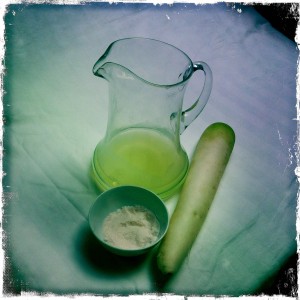 Fermented vegetables are quite foreign to the modern western diet but travel back in history and to our eastern block neighbours and you will find it in all forms and tastes. Thankfully this humble side dish that can accompany many different meals is making a name for itself on the modern dinner table. And not just for it’s taste. Fermented vegetables have got goodness written all over them.
Fermented vegetables are quite foreign to the modern western diet but travel back in history and to our eastern block neighbours and you will find it in all forms and tastes. Thankfully this humble side dish that can accompany many different meals is making a name for itself on the modern dinner table. And not just for it’s taste. Fermented vegetables have got goodness written all over them.
Technically, fermentation is the biochemical conversion of sugars, starches, or carbohydrates, into alcohol, and organic acids, by bacteria and enzymes. This process is possibly the oldest form of preserving food. The bacteria change foods into more digestible and nutritional material mainly through lactic acid. Lactic acid produces enzymes as well as promoting growth of good bacteria in the intestinal tract. The enzymes help with predigestion of foods and overcoming any intolerances that may be present. For eg. if you are intolerant to dairy foods it’s usually because the enzymes that you need to digest dairy are not present or strong enough in your own system. Therefore eating a fermented dairy product like kefir, yoghurt or cream cheese will aid you in the process of digesting dairy.
I first discovered fermented or cultured vegetables on my journey back from candidiasis. For the health of my gut and brain as well as my family’s I have kept fermented vegetables a part of our daily diet.
Here are some of the ways you can ferment or culture vegetables.
1. Whey and Salt Method
Fermented Vegetables

This humble side dish that can accompany many different meals is making a name for itself on the modern dinner table.
- Whey – comes from making this homemade cream cheese recipe You will need 4 tablespoons of whey.
- Sea salt – 2 tablespoons
- Vegetables – Daikon (cabbage (red, chinese, green etc), cauliflower, zucchini, carrot, red pepper, fennel etc. Vegetables that are hard root vegetables are the best but I have used zucchini and red pepper as well. You will need about 1.5 kgs in total of vegetables.)
- Spices and flavours – ginger (garlic, red onion (haven’t used this yet, but would like to try), caraway seeds, basil, coriander, parsley, mint or any other fresh herb you have.)
- A jar for fermenting in. Eg: Mason jar with seal and spring lever or any glass jar that has a good sealed lid. The jar needs to be about 2 litre capacity.
- Food processor. I like to grate and dice my vegetables. I know some people who are happy to grate or dice by hand (I’m not one of them.)
- A bowl or container big enough to hold all the vegetables.
- A meat cleaver or wooden rolling pin for squeezing water out of vegetables.
- Wash and peel vegetables ready to be grated or diced.
- Scold all your utensils with hot water and dry.
- Grate or dice vegetables.
- Put the vegetables into the bowl with salt (2 tbls) and whey (4 tbls).
- Using the wooden rolling pin or meat mallet or your hands begin to squeeze the mixture together until liquid rises about 1 cm above the veggies. Be careful to not overfill as the veggies will expand as they start to ferment.
The fermentation takes approximately 3-5 days to ferment. The longer they ferment the softer the vegetables become and they taste more sour.
The finished product!
2. Cultured vegetables using a purchased probiotic mixture.
The product I use for this is called Veggie Culture Starter from Body Ecology
It comes with 6 sachets and instructions. Each sachet will yield at least 7 batches of vegetables or cream fraiche.
This process is similar to no 1. but has 1 more step which is activating the culture 20 minutes before adding to vegetables.
Here is the full recipe for cultured veg here.
3. Using salt alone.
This process is even more simple than the first two, although I don’t find the taste as good.
Follow all the steps in the first method using whey but omit the whey and add an extra tablespoon of salt.
Proceed with the mixing and squeezing of the vegetables, put in the mason jar and let it sit for 3-5 days.































